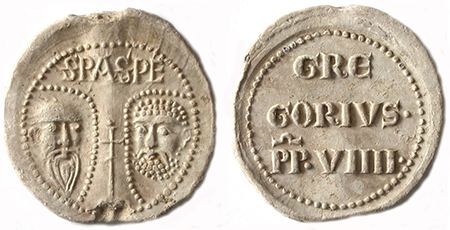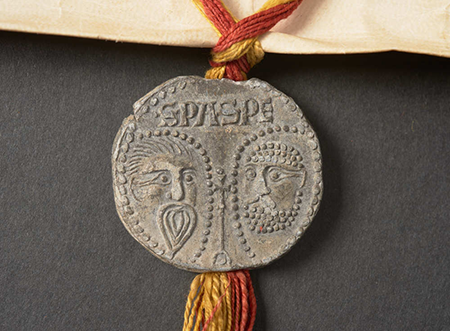



Papal Bulla: An Emblem of Papal Authority
The practice of using a bulla can be traced to the 6th century during the tenure of Pope Gregory I, a period marked by the increasing organization of the Catholic Church. While the use of seals predates Christianity and was common in ancient Mesopotamian, Egyptian, and Roman traditions, the Church adapted this method to meet its specific needs for official documentation
The term "bulla" originates from the Latin word meaning "bubble," a reference to the rounded shape of the lead seal. During the Middle Ages, the bulla became a hallmark of papal bulls, the formal decrees issued by the pope. Beyond its practical purpose of authentication, the bulla embodied the spiritual authority and administrative reach of the papacy, serving as a tangible expression of the Church’s power and its broader ambitions to shape Christendom. This transition from practical necessity to symbolic significance underscores how the Church leveraged even seemingly mundane objects to project divine authority.
The design of a papal bulla is deeply rooted in symbolism, carrying layers of theological and historical meaning. The obverse side of the seal typically bears the effigies of Saints Peter and Paul, the foundational apostles of the Church and patron saints of Rome. Saint Peter is often depicted holding the keys to the kingdom of Heaven, emphasizing his role as the Church's first leader and the symbolic gatekeeper of salvation. Saint Paul, often shown with a sword, represents his martyrdom and his missionary efforts to spread Christianity.
The reverse side of the bulla features the name of the reigning pope, accompanied by the abbreviation "PP," which stands for "Papa Pontifex," meaning "Pope and Pontiff." These inscriptions and images were meticulously crafted to convey the pope’s spiritual authority and to ensure the authenticity of the attached document. Over time, the artistic style of bullae evolved, reflecting the broader cultural and aesthetic developments of their respective eras, yet their core symbolism remained consistent, bridging centuries of papal tradition and governance. The intricate craftsmanship of the bulla demonstrates the Church’s dedication to merging administrative needs with artistic expression, creating objects of both practical and spiritual importance.
The production of a bulla was an intricate process requiring both technical precision and artistic skill. Craftsmen began by preparing a blank disc of lead, a material chosen for its durability and malleability. The design was then impressed onto the lead using engraved dies, which were carefully crafted to ensure that the imagery and inscriptions were clear and precise. The legibility of these marks was crucial, as the seal's primary purpose was to serve as a secure and recognizable sign of papal authority
The bulla was attached to the corresponding document using cords made of hemp or silk, with the type of cord indicating the nature of the document. Hemp cords were used for solemn or judicial documents, while silk cords were reserved for celebratory or honorary purposes. In certain cases, bullae featured decorative elements such as gilding, adding an additional layer of prestige to documents of particular importance. The process combined artistry with a sense of divine purpose, as these seals were not merely administrative tools but physical manifestations of the Church’s authority. Each step in the production reflected the Church’s commitment to ensuring that its communications were both secure and imbued with symbolic gravitas.
The historical significance of the papal bulla extends beyond its function as a seal. Bullae were employed to validate a wide variety of documents, ranging from doctrinal proclamations and canon law to political treaties, appointments of bishops, and grants of indulgences. Some of the most consequential documents in history bore these seals. For instance, the bull Unam Sanctam of 1302, issued by Pope Boniface VIII, articulated the supremacy of the papal authority over secular rulers, marking a defining moment in the history of Church-state relations.
Similarly, the bull Inter Caetera of 1493, issued by Pope Alexander VI, delineated the division of newly discovered lands between Spain and Portugal, profoundly influencing the course of colonial expansion in the Americas. These documents, adorned with their unique bullae, served as testaments to the authority and influence of the papacy during pivotal junctures in global history, demonstrating how far-reaching and impactful the Church’s decisions could be. In essence, the bulla was a physical manifestation of decisions that shaped nations, redefined borders, and influenced the destinies of millions.
The study of papal bullae offers valuable insights into the administrative practices and far-reaching influence of the medieval Church. Archaeological discoveries of bullae in monastic sites, cathedrals, and archives have illuminated the geographic extent of papal communications. In some instances, bullae have been unearthed in unexpected locations, such as trade centers and urban marketplaces, highlighting their integration into broader economic and social networks.
These artifacts not only reveal the logistical capabilities of the Church but also provide a tangible connection to the historical events and figures associated with them. Each bulla tells a story, reflecting the intricate network of relationships, negotiations, and decisions that defined the Church’s role in medieval society. This network extended beyond ecclesiastical borders, influencing secular rulers and the daily lives of the faithful, creating a lasting legacy of interconnectedness between the spiritual and temporal realms. The discovery and analysis of these seals enrich our understanding of how the Church operated within and beyond its spiritual dominion.
Advancements in modern technology have significantly enhanced the study and preservation of papal bullae. Non-invasive analytical methods, such as X-ray fluorescence spectroscopy, allow researchers to determine the composition of the lead without causing damage to the artifact. Such analyses have revealed details about the sources of raw materials and the manufacturing techniques employed in their production. Additionally, digital imaging and 3D modeling have revolutionized the documentation and study of bullae, enabling scholars to examine their intricate designs with unprecedented precision.
These technologies have also facilitated broader public access to these historical artifacts, fostering greater appreciation for their cultural and historical significance. By digitizing these artifacts, historians and enthusiasts alike gain the ability to explore the craftsmanship, inscriptions, and broader context of the bullae in a way that bridges the gap between the past and the present. This digital preservation ensures that the legacy of the bulla continues to inspire future generations.
The cultural and historical importance of the papal bulla lies in its ability to encapsulate the multifaceted role of the Catholic Church as a unifying force in medieval and early modern Europe. As physical manifestations of the papacy’s spiritual and political authority, bullae symbolize the Church’s capacity to govern and communicate across vast and diverse territories. The combination of artistic craftsmanship, theological symbolism, and administrative function embodied in a bulla underscores its role as both an instrument of governance and a work of art.
Through their enduring legacy, bullae continue to offer insights into the complex interplay of faith, power, and culture that defined the medieval world. By examining these seals, we gain a deeper understanding of how the Church maintained its influence and navigated the challenges of governing a widespread and diverse flock.
In conclusion, the papal bulla is far more than a simple lead seal; it is a profound emblem of the Catholic Church’s historical authority and influence. These artifacts bridge the realms of religion, art, and administration, providing a tangible link to the rich and multifaceted history of the papacy. As research and preservation efforts progress, papal bullae will undoubtedly continue to yield new discoveries and deepen our understanding of the Church’s pivotal role in shaping the course of history. The study of these remarkable objects not only enriches our knowledge of the past but also underscores the enduring legacy of the Catholic Church’s spiritual and cultural contributions to the world, ensuring that the echoes of its authority resonate through time. These small seals stand as mighty reminders of the vast reach and impact of papal governance and its influence on the course of human history.
Author: Simon Ellis
Date: 26th, January 2025
Date: 26th, January 2025

Often a bucket lister for Detectorists a papal bulla, the lead seal affixed to official documents issued by the pope, holds profound historical, religious, and artistic significance. These small yet powerful objects have served for centuries as symbols of papal authority and authenticity, reflecting the Church's pivotal role in shaping the spiritual and political landscape of Europe and beyond. The origins, intricate designs, and enduring legacy of the papal bulla provide a window into the rich tapestry of the Catholic Church’s history, demonstrating the interplay of theology, governance, and artistic tradition. Over time, the papal bulla has emerged not only as an administrative tool but also as a piece of religious art that embodies the sanctity and power of the Church.

Depiction of St Peter and St Paul

Papal Bulla on cord showing how they were used
Lead bulla (obverse and reverse) of Gregory IX, pope 1227 to 1241


